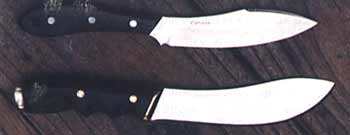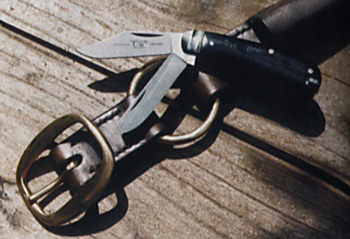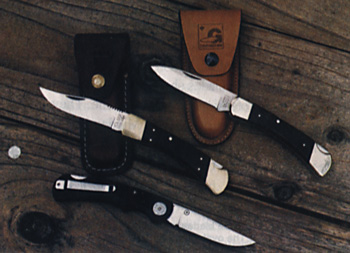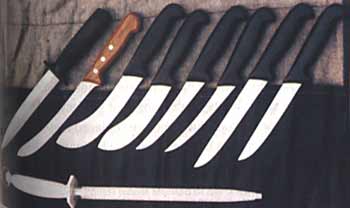Sports knives and trade blades
by Keith Spencer
Hunter 6
 When you are embarking upon an organised hunting expedition, you can
plan to carry whatever you want in the way of bladeware to accommodate
the game you expect to take, in keeping with the way you intend to hunt
for it. Unless you are really travelling light, you have the luxury of
carrying sports knives on your belt and trade blades in a wrap in your bag.
When you are embarking upon an organised hunting expedition, you can
plan to carry whatever you want in the way of bladeware to accommodate
the game you expect to take, in keeping with the way you intend to hunt
for it. Unless you are really travelling light, you have the luxury of
carrying sports knives on your belt and trade blades in a wrap in your bag.
Basically, the belt knives are field knives employed during hunting forays that are often conducted on foot over reasonably long distances or maybe using some form of transport (vehicle, bike, boat, horse) or sometimes via a stake-out (hide). Trade blades are usually employed to more carefully process game back home or at the base camp, depending upon how long or far you are away from home.
Sports knives, also referred to as recreational bladeware, take the form of fixed blade belt knives and folding lockblade knives carried in a pouch on the belt. Called skinners, hunters and utilities, fixed blade sports knives range in blade length from 8cm to 12cm and maybe straight-backed or upswept. They must be robust with a blade configuration that allows them to be used to skin and slice, as well as negotiate joints and other boning tasks.
Some hunters prefer utilitarian knives that are a little larger and longer, but not in the dimensions of Bowie-styles or heavy-duty camp knives. Most Australian game can be efficiently processed with relatively small blade lengths. Some blades are specially shaped, the most notable inclusion being a guthook to obviate penetrating the intestine when slitting skin covering the belly region.
While serious users have reservations about choosing folding lockblades as survival knives because they have working parts that can clog and break, they are, nevertheless, popular in the hunting fraternity because of their compactness and ease of carriage, particularly in horizontal belt pouches. These out-of-the-way pouches can be slipped onto the belt. Alternatively, a folder-pouch can be permanently stitched onto your hunting belt, preferably on the front left-hand side near the belt buckle or at the back in the centre (small of back).
 Pocketknives, too, can be neatly tucked into belt pouches. The main
benefits associated with pocketknives are their multiple blade options,
which means you can do lots of little cutting jobs with them. However,
in the heat of the hunt, perhaps when you need to work fast at night,
it’s very comforting to hear (and feel) that positive click that tells
you the blade is securely locked into place ready for use. The last
thing hunters want to do is spill their own blood on a weekend away
among the weeds.
Pocketknives, too, can be neatly tucked into belt pouches. The main
benefits associated with pocketknives are their multiple blade options,
which means you can do lots of little cutting jobs with them. However,
in the heat of the hunt, perhaps when you need to work fast at night,
it’s very comforting to hear (and feel) that positive click that tells
you the blade is securely locked into place ready for use. The last
thing hunters want to do is spill their own blood on a weekend away
among the weeds.
Your wrap of trade blades should contain five knives, which is all you need to professionally process game. They are a sticker, skinner, boner, butcher and filleter. Mind you, in the same way that owning a kit of mechanic’s tools doesn’t automatically make you a mechanic, neither does owning a wrap of slaughterman’s tools mean you are an adept slaughterman or fully-fledged butcher. It just means that at least you have the right tools for the job. Like anything worth knowing, you need to learn the ropes and practise a lot - practice makes perfect, or so they say.
As a young hunter, taught to hunt, shoot and gut by my older brother in the 1950s, I carried two carbon steel trade blades: a 15cm blade sticker and a 20cm blade butcher. In addition to handcrafting greenhide belt sheaths for them, I also customised the plain timber handles exactly the same with finger and thumb grooves for comfort and safety. The trademarks have long since worn off and it’s too long ago to remember the brand name.
I do remember that I had earlier owned a Crown brand butcher knife, which I lost one night while running across a paddock through chest-high wheat. We were spotlighting on a wintry night and I failed to secure the knife in its sheath. As I ran, the cuff of my jacket sleeve must have hooked the knife out into the crop. I searched in vein the next day for the knife with a gold crown etched onto the butt of the knife handle. I was 19…you live and learn.
 Trade blades rarely have guards. My butcher blade was used to slice and
drawn through the meat and was therefore safe to work with. My sticker
blade, on the other hand, was pushed to pierce and slit to kill game
that was down. I was taught never to waste a bullet and to make as
little noise as possible. To safely push a guard-less knife, you need a
thumb-ramp and recesses into which the fingers can tightly curl so that
the knife remains firmly in the hand, even when wet.
Trade blades rarely have guards. My butcher blade was used to slice and
drawn through the meat and was therefore safe to work with. My sticker
blade, on the other hand, was pushed to pierce and slit to kill game
that was down. I was taught never to waste a bullet and to make as
little noise as possible. To safely push a guard-less knife, you need a
thumb-ramp and recesses into which the fingers can tightly curl so that
the knife remains firmly in the hand, even when wet.
Far more carbon steel trade blades these days have shaped timber handles and all the stainless steel trade blades used in abattoirs and the hospitality industry have well shaped injection moulded plastic grips. However, very few sheaths are made to house trade blades and those that are available are mainly plastic and not hunter-friendly.
There are umpteen attractive variations of sports knives utilising all sorts of grip, guard and pommel materials. Trade blades, on the other hand, come in set shapes and styles and materials and are quite bland by comparison. They are strictly working knives and, although trade personnel don’t abuse these edged tools, they are extensively used and frequently sharpened, so they wear quickly, get discarded and then a new knife is broken in by the knife worker. Trade blades are designed to have a fairly short, hard-working cycle of existence, whereas the less used, stylish-looking sports knives are made to be about for a few generations of ownership.
Smart manufacturers, recognising the demand for less expensive sports knives with a high work ethic, produce plainer looking, economy models with the emphasis on good grip ergonomics and good blade integrity. Although basic sports blade shapes are preserved, these models are conceived to bridge the void between plain trade blades and stylish sports knives. And you will pay about the same for a basic sports knife as you do for a good quality trade blade, but you are spared the job of having to handcraft a sheath for it.
Lots of users swear by carbon blades and wonder why there aren’t many sports knife blades produced out of tool steels such as 01 and D2. The cutlery manufacturers will tell you that the main demand is for stainless steel blades. Forgive me for being sceptical, but I do not believe this to be altogether true.
Product demands are created by manufacturers who continue coming up with new products in order to maintain and improve the market share of their brands. They don’t ask us what we want; hence the reason that perfectly practical knives become discontinued and are replaced by products the manufacturer tells us work better. The manufacturers manipulate the market and we get to use the knives they deliver into our hands, endorsed by eager knife writers delighted to promote anything that’s new and trendy.
Another important reason why manufacturers primarily produce and promote stainless instead of carbon blades is because they don’t tarnish and rust laying on display for long periods in retail stores. Carbon steel blades need constant attention, given they are handled by staff and potential buyers with sweaty hands that sets off corrosion. Damp humid and cold conditions also attack carbon blades openly displayed, making them impossible to sell as pristine new items.
 Sports blades - belt knives for hunters - need to be more durable and
of a higher Rockwell Hardness than trade blades because they need to
absorb the rigours of field use. Hunters hunt in all kinds of
conditions and circumstances. The single knife you carry must fulfil
its intended purpose on game brought down, probably some distance from
the camp-site. You may not wish to waste precious time re-sharpening
your belt knife when daylight or darkness is waning or the window of
hunting opportunity is limited. RC56-58 provides a serviceable
edge-holding hardness on mainstream sports knife steels (carbon and
stainless).
Sports blades - belt knives for hunters - need to be more durable and
of a higher Rockwell Hardness than trade blades because they need to
absorb the rigours of field use. Hunters hunt in all kinds of
conditions and circumstances. The single knife you carry must fulfil
its intended purpose on game brought down, probably some distance from
the camp-site. You may not wish to waste precious time re-sharpening
your belt knife when daylight or darkness is waning or the window of
hunting opportunity is limited. RC56-58 provides a serviceable
edge-holding hardness on mainstream sports knife steels (carbon and
stainless).
Trade blades, generally employed to process game back at the camp when time constraints are less pressing, are slimmer to carry out finite cuts more precisely. You can choose the right blade shape and dimensions for the job and because the Rockwell Hardness of trade blades is generally lower than that of sports knives, you can keep them razor-sharp by frequently touching them up on a fine-cut or polished sharpening steel beside you on the table.
Hunting ought not be a rip, snort and bust affair, but a carefully orchestrated event. A scientific approach is urged: all the hunting gear should be restored to good working order after every hunt and be properly maintained during the interim, in readiness for the call to hunt at short notice.
Naturally, every edge in the kit should be honed to shaving sharpness; however, it is important to be well practised in the technique of blade-work as it applies to hunting, using both sports knives and trade blades. I recall an occasion on a farm where I was hunting when I worked alongside an old fellow who was a qualified and very experienced butcher.
He had been summoned to the property by the farmer to dispatch and dress a couple of bovines for the freezers. I had been taught a bit about dressing stock and offered to give him a hand. I shot them both for him. One flipped over onto its back like it was supposed to do. The other crumpled stone dead onto its side rather than flipping over. There was only one gambrel and the old fellow graciously allowed me to use it, so the beast on its side was hauled up by a front-end loader with the gambrel through its hind legs. The old fellow unwrapped his trade blades, bent his back and set about processing the beast on its back on the ground.
 At the time I was carrying two sports knives: a design award winning
Canadian DH Russell belt knife model R1 and its bigger brother the R4.
I reckoned I had the easier row to hoe, standing upright to make most
of the incisions and doing the hard yakka before eventually needing to
lay the beast down again to finish the work.
At the time I was carrying two sports knives: a design award winning
Canadian DH Russell belt knife model R1 and its bigger brother the R4.
I reckoned I had the easier row to hoe, standing upright to make most
of the incisions and doing the hard yakka before eventually needing to
lay the beast down again to finish the work.
Boy, did I get a lesson, not that there was any competition going on between us? But he was so quick and efficient, that by the time I was half done, he was finished and then moved in alongside me to demonstrate with his trade blades the finer points of what I believe to be an art form. It’s all about using good tools and applying the correct technique. Thanks, old fellow, wherever you’ve come to rest.
Captions
Image 1: Classic sports knife (top)
Canadian-made DH Russell R4 and a traditional trade skinner-style
(bottom) hand-crafted by full-time knifemaker Simon Jurkijevic of the
Northern Territory.
Image 2: Lockable folding hunters, top to
bottom: Model R380S Grohmann-Canada, model 1189 Ka-Bar-USA, and
lightweight model 3005 tactical-type Ka-Bar-USA with belt clip.
Image 3: This hand-stitched best quality
stockman's leather belt by Miller & Gibbs of NSW features a
pocketknife pouch. Shown here is the Sheffield-made Taylors Eye
Wittness model 421 with the clip and castrator blades and picker and
tweezer tuckered into the butt section.
Image 4: The author's 40-year-old retired trade
blades, a sticker and a butcher, with customised timber grips.
Image 5: A wrap of top quality trade blades
manufactured in Germany under the trade of F Dick. The oval sharpening
steel is manufactured and marketed by Egginton of Sheffield, England.
